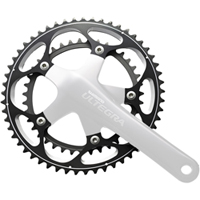Use your gears wisely and get the most out of every ride, writes Stephen Huntley.
Being equipped with the right gears for the sort of riding you like to do is an important part of having an enjoyable experience on your bike, but many riders simply accept whatever gearing their bike came with, and rarely demand anything that may be more suitable.
And even if fitted with an ideal range of gears, the best and most efficient way to use them when riding isn’t always immediately obvious. But take a closer look, make some simple calculations, and your gears’ real magic can be revealed.
Spin cycle
Experienced riders will tell you that gearing is all about keeping up a consistent and comfortable amount of pedal turns per minute – your cadence – whether the road is going uphill, flat, downhill, or you’re riding into a howling wind.
A novice rider may struggle along spinning the pedals 40 or 50 times per minute, but the pros in the peloton will be aiming at riding all day while spinning at about 90 times per minute. For the rest of us, trying to aim for close to 80 turns per minute is reasonable and achievable after a bit of practice.
To try and hit that mark, the next time you’re riding along a nice flat stretch, try and set your cruising gear combination so that you can just comfortably spin your pedals at 13 to 14 turns every 10 seconds.
As you come to a rise in the road, don’t pedal any slower; instead, drop your gears down to a combination that will allow you to still comfortably go up the hill at the same cadence of 80 turns per minute.
As you start going down the other side, your legs will start spinning like crazy, so change up to a harder gear; slightly harder than your cruising gear, so once again you feel comfortable at making 80 turns per minute. And so on.
Keeping a high and consistent cadence is the most efficient way to ride long distances, is a great way to burn off fat, and is kinder to the knees and your bike’s drive system than grinding away slowly in big gears.
As you get fitter and stronger you will find your cruising gear will have become too easy, and you’ll have to move on to a bigger combination. It’s a real and satisfying mark of improved riding ability when this happens.
The good gear

Your combinations of front and rear gears allow you to have a mechanical advantage over having one pedal stroke equalling one turn of the wheel.
Before gearing, bikes had no such advantage. Think of the penny farthing: as the pedal is turned, the giant front wheel moves in exact sync. The reason the front wheel is so big is that if it was any smaller, you’d have to spin the pedals like mad to get anywhere, and if the wheel was bigger, apart from the even greater damage a fall would cause, it would be too hard to ride up a hill.
Your gears can be thought of in similar terms; if the combination of gears you are in means one revolution of the pedals equals one complete turn of the back wheel, you’re in a very easy gear. If the combination leads to one revolution of the pedals equalling four turns of the back wheel (the equivalent of turning a giant wheel four times its circumference) you’re in a very hard gear.
To determine the ratio of pedal revolution to wheel revolution is easy; count how many teeth there are in the front chainring gear you are in, and how many in the back gear you are in. If they are equal in number, then one full turn of the pedal will lead to one full turn of the back wheel. If there are four times as many teeth in the front gear compared to the rear gear you’re in, then one complete turn of the pedals will spin the rear wheel four times.
Counting your gear teeth can seem like a bit of a bore, but it is well worth doing as a one-off exercise; just make sure you record the results so you don’t have to do it twice!
You can then set up a simple table for your gears, as per Chart One shown. It is of value just to work out and enter the ratios of each combination of gears, but it’s more worthwhile going one step further than that. Chart One, for instance, tells us, for each gear combination, how far the bike will travel for one turn of the pedals.
Wheel workout
To fill out your chart, we need to know how far your bike travels in one turn of your wheel; ie, the circumference of your wheel. There are a few ways to do this, but probably the simplest is to measure the width of the back wheel with your tyre on and pumped up (its diameter), then multiply the result by Pi (3.14).
You can estimate circumference without a tape measure, however. For a 700C wheel, which is what most non-mountain-bike bikes are fitted with, the wheel diameter without the tyre is 622mm. On my bike, the tyres are 25mm in height (your tyre’s width, which equals it’s height, is written on its sidewall). So the overall diameter for my rear wheel is 622+25+25; 672mm. The circumference is 672 multiplied by 3.14, which makes 2110mm. So, for one turn of the wheel, my bike moves forward 2.11 metres.
Back to the chart, and for each individual combination of gears we divide the front gear teeth number by the rear gear teeth number, then multiply that number by our circumference (2.11m). See our Chart 1 for workings out for a 50–34 front, 12–27 rear gear setup.
As an example, in a 34–19 toothed combination, 34 divided by 19 is 1.79; 1.79 multiplied by 2.11 metres is 3.77 metres. So in the 34–19 gear combination, if I turn the pedals once, I’ll move forward 3.77 metres.
Ideal couples

A chart like this will quickly show redundant gears, or those combinations that are almost identical. For instance, in our chart, you can see that when in the largest front chainring, once you get past the 19-tooth rear cog, you may as well change down into the smaller front chainring with a 14 rear cog.
The chain and derailleurs also work most efficiently, and wear is reduced, if you use gear combinations that keep the chain relatively straight. Try not to use extreme diagonal gear combinations; eg, from our chart, the 50 chainring with the 24 or 27 rear cogs, or the 34 chainring with the 12 or 13 rear cogs.
Cruising speed
You can now work out your probable speeds for each gear combination given your normal cadence. For example, if your typical cruising gear was the mid-range combination 50–16, for every one turn of the pedal you’d advance the bike forward 6.59 metres.
If your cadence was at 80 turns per minute, in a minute you’d travel 527.2 metres (over half a kilometre). In an hour you would cover 31,632 metres; ie, when in the 50–16 gear combination and going at a standard cadence, you’re travelling at just over 31km/h. See Chart 2 for expected speeds at all gear combinations.
Change up

These charts can give you a good point of comparison if you find your gears are too limited. Most derailleur systems can handle a range of rear gears and front chainrings. For instance, the rear cassette used for our chart is a Shimano 105 12–27. If you wanted a bit more downhill speed and an easier gear to get up hills, you could switch to the Shimano 105 11–28.
Touring bikes normally come with a much wider range of gears, including three front chainrings, known as a ‘triple’. The bike is likely to be heavier, and could be carrying a lot of extra weight in panniers, etc, so easier gears are important. A typical combination is a 50–39–30 triple front chainring, with an 11–34 rear cassette. That means in its easiest gear combination (30 on the front, 34 on the rear), for one turn of the pedal on our wheels, the bike will go just 1.86 metres. It will also be very easy to pedal up hills.
If you’re a power road rider and you want to go fast, a typical combination is a 53–39 front chainring and an 11–25 rear cassette. It doesn’t leave an easy gear for hill climbing but does have a big, fast gear; the hardest combination is equivalent to 10.17 metres travel per pedal stroke on our wheels.
If you can push that gear combination at 80 turns of the pedals per minute, you’ll be flying at 49km/h!
Ride On content is editorially independent, but is supported financially by members of Bicycle Network. If you enjoy our articles and want to support the future publication of high-quality content, please consider helping out by becoming a member.





for measuring gear ratios: gear inches , metres of development (roll-out), gain ratio , and front/rear (racing-style). The first three methods result in each possible gear ratio being represented by a single number which allows the gearing of any bicycles to be compared; the numbers produced by different methods are not comparable, but for each method the larger the number the higher the gear. The fourth method uses two numbers and is only applicable to racing bicycles with derailleur gears which have a specific wheel size (rim diameter 622 mm, often referred to as 700C).